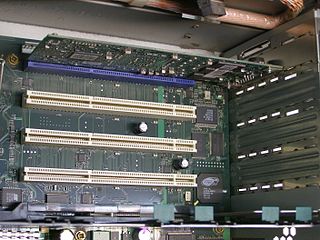
Accelerated Graphics Port (AGP) is a parallel expansion card standard, designed for attaching a video card to a computer system to assist in the acceleration of 3D computer graphics. It was originally designed as a successor to PCI-type connections for video cards. Since 2004, AGP was progressively phased out in favor of PCI Express (PCIe), which is serial, as opposed to parallel; by mid-2008, PCI Express cards dominated the market and only a few AGP models were available, with GPU manufacturers and add-in board partners eventually dropping support for the interface in favor of PCI Express.

Peripheral Component Interconnect (PCI) is a local computer bus for attaching hardware devices in a computer and is part of the PCI Local Bus standard. The PCI bus supports the functions found on a processor bus but in a standardized format that is independent of any given processor's native bus. Devices connected to the PCI bus appear to a bus master to be connected directly to its own bus and are assigned addresses in the processor's address space. It is a parallel bus, synchronous to a single bus clock. Attached devices can take either the form of an integrated circuit fitted onto the motherboard or an expansion card that fits into a slot. The PCI Local Bus was first implemented in IBM PC compatibles, where it displaced the combination of several slow Industry Standard Architecture (ISA) slots and one fast VESA Local Bus (VLB) slot as the bus configuration. It has subsequently been adopted for other computer types. Typical PCI cards used in PCs include: network cards, sound cards, modems, extra ports such as Universal Serial Bus (USB) or serial, TV tuner cards and hard disk drive host adapters. PCI video cards replaced ISA and VLB cards until rising bandwidth needs outgrew the abilities of PCI. The preferred interface for video cards then became Accelerated Graphics Port (AGP), a superset of PCI, before giving way to PCI Express.

NuBus is a 32-bit parallel computer bus, originally developed at MIT and standardized in 1987 as a part of the NuMachine workstation project. The first complete implementation of the NuBus was done by Western Digital for their NuMachine, and for the Lisp Machines Inc. LMI Lambda. The NuBus was later incorporated in Lisp products by Texas Instruments (Explorer), and used as the main expansion bus by Apple Computer and a variant called NeXTBus was developed by NeXT. It is no longer widely used outside the embedded market.
HyperTransport (HT), formerly known as Lightning Data Transport, is a technology for interconnection of computer processors. It is a bidirectional serial/parallel high-bandwidth, low-latency point-to-point link that was introduced on April 2, 2001. The HyperTransport Consortium is in charge of promoting and developing HyperTransport technology.

Secure Digital, officially abbreviated as SD, is a proprietary non-volatile flash memory card format developed by the SD Association (SDA) for use in portable devices.

Octane series of IRIX workstations was developed and sold by SGI in the 2000s. Octane and Octane2 are two-way multiprocessing-capable workstations, originally based on the MIPS Technologies R10000 microprocessor. Newer Octanes are based on the R12000 and R14000. The Octane2 has four improvements: a revised power supply, system board, and Xbow ASIC. The Octane2 has VPro graphics and supports all the VPro cards. Later revisions of the Octane include some of the improvements introduced in the Octane2. The codenames for the Octane and Octane2 are "Racer" and "Speedracer" respectively.

PCI-X, short for Peripheral Component Interconnect eXtended, is a computer bus and expansion card standard that enhances the 32-bit PCI local bus for higher bandwidth demanded mostly by servers and workstations. It uses a modified protocol to support higher clock speeds, but is otherwise similar in electrical implementation. PCI-X 2.0 added speeds up to 533 MHz, with a reduction in electrical signal levels.

HP 9000 is a line of workstation and server computer systems produced by the Hewlett-Packard (HP) Company. The native operating system for almost all HP 9000 systems is HP-UX, which is based on UNIX System V.

TURBOchannel is an open computer bus developed by DEC by during the late 1980s and early 1990s. Although it is open for any vendor to implement in their own systems, it was mostly used in Digital's own systems such as the MIPS-based DECstation and DECsystem systems, in the VAXstation 4000, and in the Alpha-based DEC 3000 AXP. Digital abandoned the use of TURBOchannel in favor of the EISA and PCI buses in late 1994, with the introduction of their AlphaStation and AlphaServer systems.
The Runway bus is a front-side bus developed by Hewlett-Packard for use by its PA-RISC microprocessor family. The Runway bus is a 64-bit wide, split transaction, time multiplexed address and data bus running at 120 MHz. This scheme was chosen by HP as they determined that a bus using separate address and data wires would have only delivered 20% more bandwidth for a 50% increase in pin count, which would have made microprocessors using the bus more expensive. The Runway bus was introduced with the release of the PA-7200 and was subsequently used by the PA-8000, PA-8200, PA-8500, PA-8600 and PA-8700 microprocessors. Early implementations of the bus used in the PA-7200, PA-8000 and PA-8200 had a theoretical bandwidth of 960 MB/s. Beginning with the PA-8500, the Runway bus was revised to transmit on both rising and falling edges of a 125 MHz clock signal, which increased its theoretical bandwidth to 2 GB/s. The Runway bus was succeeded with the introduction of the PA-8800, which used the Itanium 2 bus.

Multibus is a computer bus standard used in industrial systems. It was developed by Intel Corporation and was adopted as the IEEE 796 bus.

The SPARCstation 10 is a workstation computer made by Sun Microsystems. Announced in May 1992, it was Sun's first desktop multiprocessor. It was later replaced with the SPARCstation 20.
GIO is a computer bus standard developed by SGI and used in a variety of their products in the 1990s as their primary expansion system. GIO was similar in concept to competing standards such as NuBus or (later) PCI, but saw little use outside SGI and severely limited the devices available on their platform as a result. Most devices using GIO were SGI's own graphics cards, although a number of cards supporting high-speed data access such as Fibre Channel and FDDI were available from third parties. Later SGI machines use the XIO bus, which is laid out as a computer network as opposed to a bus.
Released as the expansion bus of the Commodore Amiga 3000 in 1990, the Zorro III computer bus was used to attach peripheral devices to an Amiga motherboard. Designed by Commodore International lead engineer Dave Haynie, the 32-bit Zorro III replaced the 16-bit Zorro II bus used in the Amiga 2000. As with the Zorro II bus, Zorro III allowed for true Plug and Play autodetection wherein devices were dynamically allocated the resources they needed on boot.

Parallel SCSI is the earliest of the interface implementations in the SCSI family. SPI is a parallel bus; there is one set of electrical connections stretching from one end of the SCSI bus to the other. A SCSI device attaches to the bus but does not interrupt it. Both ends of the bus must be terminated.

The R10000, code-named "T5", is a RISC microprocessor implementation of the MIPS IV instruction set architecture (ISA) developed by MIPS Technologies, Inc. (MTI), then a division of Silicon Graphics, Inc. (SGI). The chief designers are Chris Rowen and Kenneth C. Yeager. The R10000 microarchitecture is known as ANDES, an abbreviation for Architecture with Non-sequential Dynamic Execution Scheduling. The R10000 largely replaces the R8000 in the high-end and the R4400 elsewhere. MTI was a fabless semiconductor company; the R10000 was fabricated by NEC and Toshiba. Previous fabricators of MIPS microprocessors such as Integrated Device Technology (IDT) and three others did not fabricate the R10000 as it was more expensive to do so than the R4000 and R4400.
VPro, also known as Odyssey, is a computer graphics architecture for Silicon Graphics workstations. First released on the Octane2, it was subsequently used on the Fuel, Tezro workstations and the Onyx visualization systems, where it was branded InfinitePerformance.

DEC 3000 AXP was the name given to a series of computer workstations and servers, produced from 1992 to around 1995 by Digital Equipment Corporation. The DEC 3000 AXP series formed part of the first generation of computer systems based on the 64-bit Alpha AXP architecture. Supported operating systems for the DEC 3000 AXP series were DEC OSF/1 AXP and OpenVMS AXP.

The GeForce 9 series is the ninth generation of Nvidia's GeForce series of graphics processing units, the first of which was released on February 21, 2008. Products are based on a slightly repolished Tesla microarchitecture, adding PCIe 2.0 support, improved color and z-compression, and built on a 65 nm process, later using 55 nm process to reduce power consumption and die size.
HP X-Terminals are a line of X terminals from Hewlett Packard introduced in the early- to mid-1990s, including the 700/X and 700/RX, Envizex and Entria, and the Envizex II and Entria II. They were often sold alongside PA-RISC-based HP 9000 Unix systems. The primary use case was connecting several graphical consoles to a single server or workstation to allow multiple users access the same (expensive) processing system from terminal systems. These X-Terminals all allowed high-resolution, color-graphics access to the main server from which they downloaded their operating system and necessary program files. All models featured limited expandability, in most cases additional I/O options for peripherals and memory for more programs or local storage. HP did not use its own PA-RISC platform for these systems, the first design used an Intel CISC processor, while all later systems used RISC platforms, first Intel i960 and later the popular MIPS.















